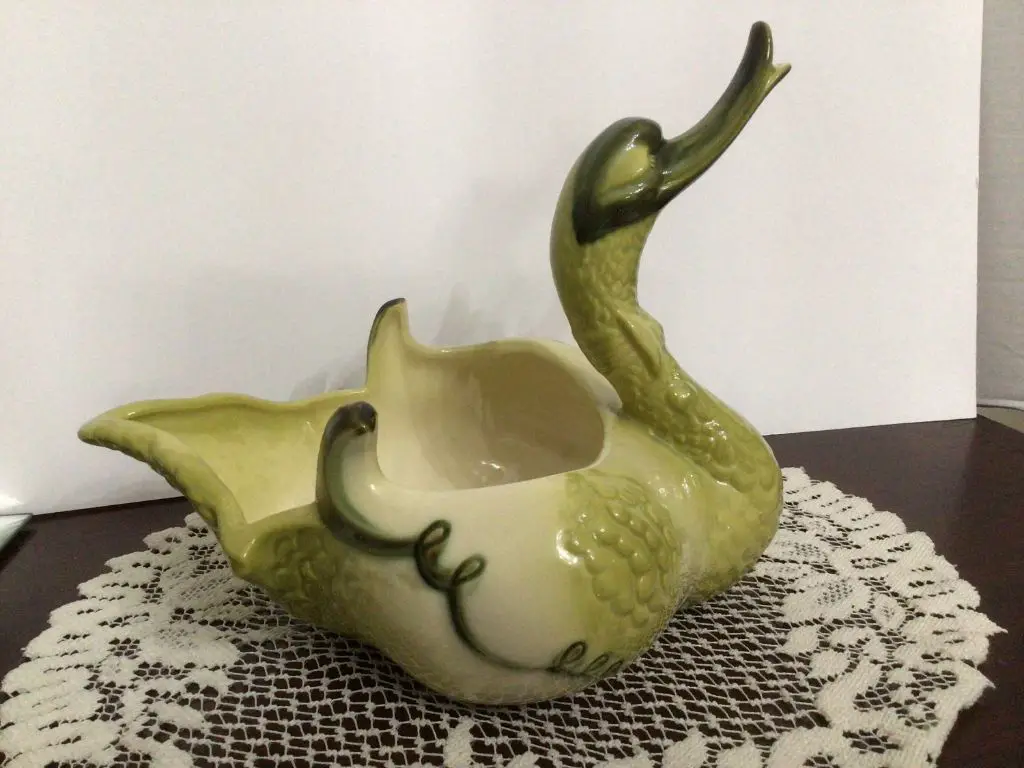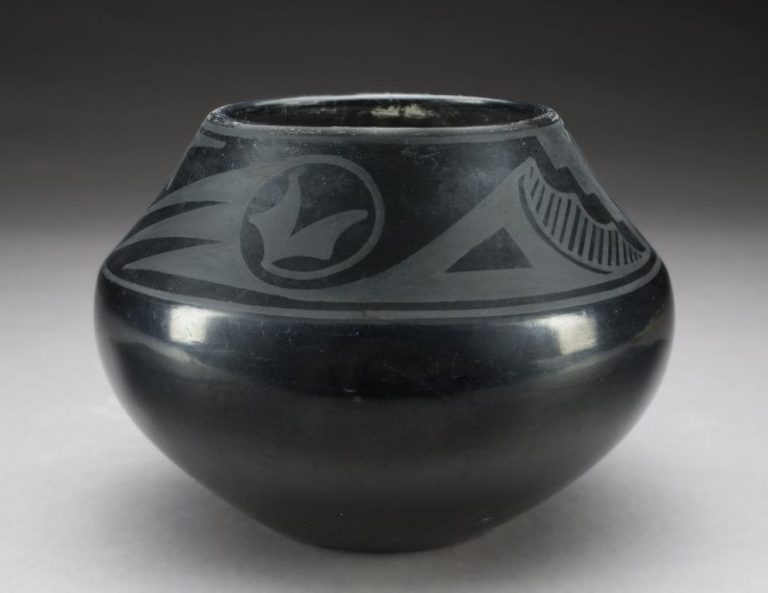Is Hull Pottery Valuable Today?
Hull Pottery began production in 1905 in Crooksville, Ohio under the leadership of Addis Emmet Hull. The company specialized in producing art pottery using innovative production techniques like molded shapes and bright, glossy glazes https://hullpotteryassociation.org/. Their pottery stood out for its colorful, stylized floral designs and Art Deco aesthetic. At its peak, Hull Pottery was the largest manufacturer of pottery in the U.S. http://realpriceguides.com/hull/his.asp. Today, Hull pottery from the early 20th century is highly desirable among collectors for its historic significance, distinctive look, and quality craftsmanship.
Characteristics of Hull Pottery
Hull Pottery is known for its distinctive shapes, unusual glazes, and production methods. Some of the most iconic Hull shapes include swans, fish, and birds. These stylized animal forms were inspired by Art Deco and Art Nouveau designs of the early 20th century (Hull pottery). The swan vases and bird-shaped cookie jars are especially sought after today.
In terms of glazes, Hull Pottery experimented with unusual speckled, streaked, and oxblood glazes starting in the 1930s. According to the Hull Pottery Association, the distinctive two-color combinations became a Hull trademark (Hull Pottery History). These glazes added visual interest and depth to the pottery.
Production methods at Hull included both hand-throwing and molding. Some of the most elaborate Art Deco designs were hand-thrown by skilled artisans, while simpler kitchenware and crockery was mass-produced using molds. Both methods resulted in high quality, visually appealing pottery.
Most Valuable and Rare Pieces
Some of the most valuable and rare Hull pottery pieces are those designed by Artus Van Briggle, who was a talented ceramicist that worked at the Hull factory in the early 1900s. Van Briggle introduced innovative glazes and decorative techniques to Hull during his time there.
Pieces designed by Van Briggle like vases and pitchers with metallic luster glazes often fetch high prices at auction, sometimes selling for thousands of dollars. His tile designs featuring cyanine glazes are also highly coveted by collectors.
Items with the earliest impressed marks used by Hull, such as the wreath and cope mold marks, are also rare and valuable finds. These pieces date back to the very beginning of Hull production in the late 19th century.
Certain decorating techniques like high relief designs, lustring, and limiting make some Hull pottery stand out. Multi-colored early examples of Rozane wares, with their brilliant hues, unique shapes and fluid lines are avidly collected.
Glazes like the difficult to produce Seahorse Blue and the elusive Oxblood glaze, found on only a handful of confirmed Hull pieces, also make these items precious to enthusiasts.
Pricing and Current Value
Hull pottery can vary greatly in price depending on rarity, condition, and demand. Here’s an overview of the pricing landscape:
For relatively common Hull pottery pieces in decent condition, prices typically range from $15 to $50. These include items like standard vases, bowls, pitchers, and planters. Mid-century and art deco styles tend to be the most affordable and available.

Rarer Hull art pottery and figurines can fetch much higher prices, especially at auction. Notable sales include a 1914 Jack in the Pulpit vase that sold for $74,000 in 2005, and a rare 1931HttpResponse World’s Fair Bowl that sold for $99,000 in 2014. Pieces designed by famous artists like Frank Lloyd Wright have sold for over $20,000.
Some factors that increase the value of Hull pottery include:
- Limited production runs of 300 pieces or less.
- One-of-a-kind custom or exhibition pieces.
- Items with impeccable condition and no damage or repairs.
- Rare glazes like oxblood or Bittersweet.
- Pieces designed by famous artists.
- Items with important historical connections.
In general, the finer and more ornate art pottery tends to command higher prices than standard utilitarian wares when it comes to Hull. And anything in short supply that collectors covet will fetch premium values.
How to Identify Authentic Hull Pieces
There are a few key hallmarks to look for when identifying authentic Hull pottery pieces:
- Look for the stamped markings like “Hull” inside a wreath, the shape number, or “USA.” These markings were used on most authentic Hull pieces.
- Examine the glaze – it should have a glossy finish in vibrant solid colors or a matte finish in pastel hues if it’s vintage Hull.
- Authentic pieces will not have cracks, chips, or excessive crazing in the glaze.
There are also some tips for spotting fakes or reproductions:
- Modern fakes often have paint that rubs off easily or glazes with incorrect finishes.
- Reproductions sometimes have markings that are stamped sloppily or inconsistently.
- The color patterns may not match those of authentic pieces.
- If the price seems too good to be true, it could be a reproduction.
Examining the bottom for authentic stamps and learning to recognize quality finishing are the best ways to avoid counterfeit Hull pottery when collecting.
Where to Buy and Sell
When looking to buy or sell Hull pottery, here are some top places to find items and connect with collectors:
Online Marketplaces
Popular auction sites like eBay and Etsy offer a wide selection of Hull pottery for sale from sellers across the country. These are great places to find rare and unique pieces. Facebook groups like Hull Pottery for Sale also connect collectors looking to buy and sell.
Antique Stores and Retailers
Specialized antique stores, flea markets, and vintage retailers may carry Hull pottery, especially in regions of the country where it was produced. These sellers can provide expertise in identifying and pricing items. Mall antique malls, antique co-ops, and shows are good places to find Hull pieces mixed with other antiques and collectibles.
Auction Houses
Major auction houses like Christie’s and Sotheby’s occasionally feature Hull pottery, particularly rare and highly valued pieces. Specialized auction houses in the Midwest may also conduct sales focused entirely on Hull and other American art pottery. These venues attract serious collectors willing to pay top dollar for exceptional items.
Caring for and Restoring Hull Pottery
Proper care and cleaning is essential for preserving antique Hull pottery. According to Care and Cleaning of Art Pottery, soaking the pottery in a hot water and ammonia mixture for at least 24 hours can help lift dirt and grime. Use a soft brush or sponge while soaking to gently remove any deposits. Avoid abrasive cleaners or pads that could scratch the surface. For stubborn stains, a diluted bleach solution may be effective, but test first in an inconspicuous area.
For cracked or chipped Hull pottery, professional restoration services are recommended. The earlier colorful glazes are difficult to match and touch-up properly. For clean breaks, special adhesives can carefully piece together the original work. Damage along edges or rims may be more difficult to repair. Restoration costs will vary depending on the rarity of the item and extent of damage. Some wear adds antique character, but visible mends will reduce value for collectors.
Historical Significance
Hull pottery played an important role in the American Arts & Crafts movement in the early 20th century. Founded in 1905, Hull House was one of the leading producers of art pottery during the Arts & Crafts era, alongside firms like Rookwood and Roseville (Wikipedia, 2023).
The intricate designs and glazes of Hull art pottery exemplified the principles of the Arts & Crafts movement, with handcrafted items that featured natural themes, rich colors, and innovative techniques. According to the Hull Pottery Association, Hull’s free-form artwares reflected the aesthetics and philosophy of Arts & Crafts style (Hull Pottery Association, 2023).
In addition to contributing to the American Arts & Crafts aesthetic, Hull pottery went on to influence later ceramic styles. Their innovative matte glazes and earthy designs paved the way for the Mid-Century modern pottery of the 1950s-60s. Many current ceramic artists cite Hull as an inspiration for their work (Wikipedia, 2023).
Overall, Hull pottery holds an important place in the history of American ceramics. As a leading producer of Arts & Crafts art pottery, Hull helped shape the aesthetics of an entire era. Their artistic legacy lives on through contemporary ceramicists who continue to draw inspiration from Hull’s innovative glazes and naturalistic designs.
Future Outlook
The popularity of Hull pottery seems likely to continue or even grow in the near future. As The Collector’s Encyclopedia of Hull Pottery notes, prices for many sought-after Hull pieces have steadily risen over the past couple of decades. This suggests continued strong demand among current collectors. There are also signs that new generations of collectors are discovering an appreciation for Hull pottery and other vintage American art pottery.
Younger collectors who have an interest in vintage decor and handicrafts are realizing that Hull pottery fits well with modern farmhouse, vintage cottagecore, and boho chic aesthetics that are currently popular. Social media is exposing many millennials and Gen Zers to Hull pottery for the first time. As these younger generations start collecting Hull, demand and prices for rare pieces may continue to increase. While the most avid collectors still tend to be older, the renewed interest from younger demographics appears promising for the future popularity and value of Hull pottery.
Conclusion
Hull pottery has stood the test of time as a collectible and valuable type of antique pottery. Its unique design aesthetic of simple, colorful, and geometric Art Deco shapes makes it easily identifiable. The most rare and valuable pieces can fetch prices in the thousands of dollars at auction for popular items like vases, planters, and figurines. Even more common Hull pieces hold value in the hundreds of dollars due to the company’s reputation for artistry and quality craftsmanship.
Today, there is an enthusiastic collector base seeking out quality Hull pottery at antique shops, online auctions, estate sales, and elsewhere. The vibrant, cheerful look of Hull pottery makes it appealing to collectors and interior decorators alike. As time goes on, Hull pottery is likely to continue gaining value, especially rare items and those in pristine condition. With proper care and restoration, Hull pottery can be treasured and handed down for generations. The history and innovation of the Hull company cement its pottery’s lasting collectibility and significance in the story of American ceramics.


